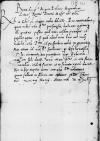List #2943
Bona Sforza do Ioannes DANTISCUSCracow (Kraków), 1546-03-28
| odebrano Heilsberg (Lidzbark Warmiński), 1546-04-10 Rękopiśmienne podstawy źródłowe:
Pomocnicze podstawy źródłowe:
| ||||||||||
Tekst + aparat krytyczny + komentarz Zwykły tekst Tekst + komentarz Tekst + aparat krytyczny
Reverendo in Christo Patri, domino
Reverende in Christo Pater, sincere nobis dilecte.
Pro novitatibus, quas nobis Vestra Paternitas perscripsit, habemus
agimusque illi gratias. Postea quid inter eosdem principes et populos agetur et si quid aliud novi boni aut mali habebit Vestra Paternitas, id perscribere nobis ne gravetur. Nos etiam id Vestrae Paternitati scribimus, quod
Quam salvam ac felicem esse optamus.
Dat(ae) or Dat(um)()⌈Dat(ae)Dat(ae) or Dat(um)()⌉


 BCz, 3465, p. 322
BCz, 3465, p. 322